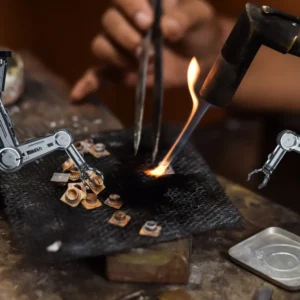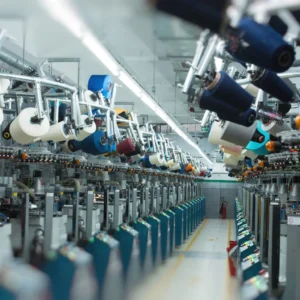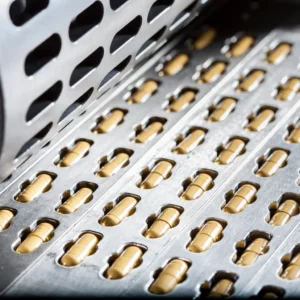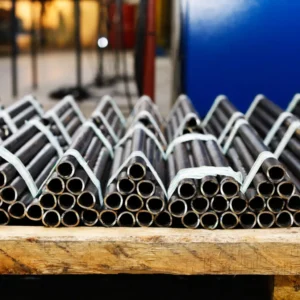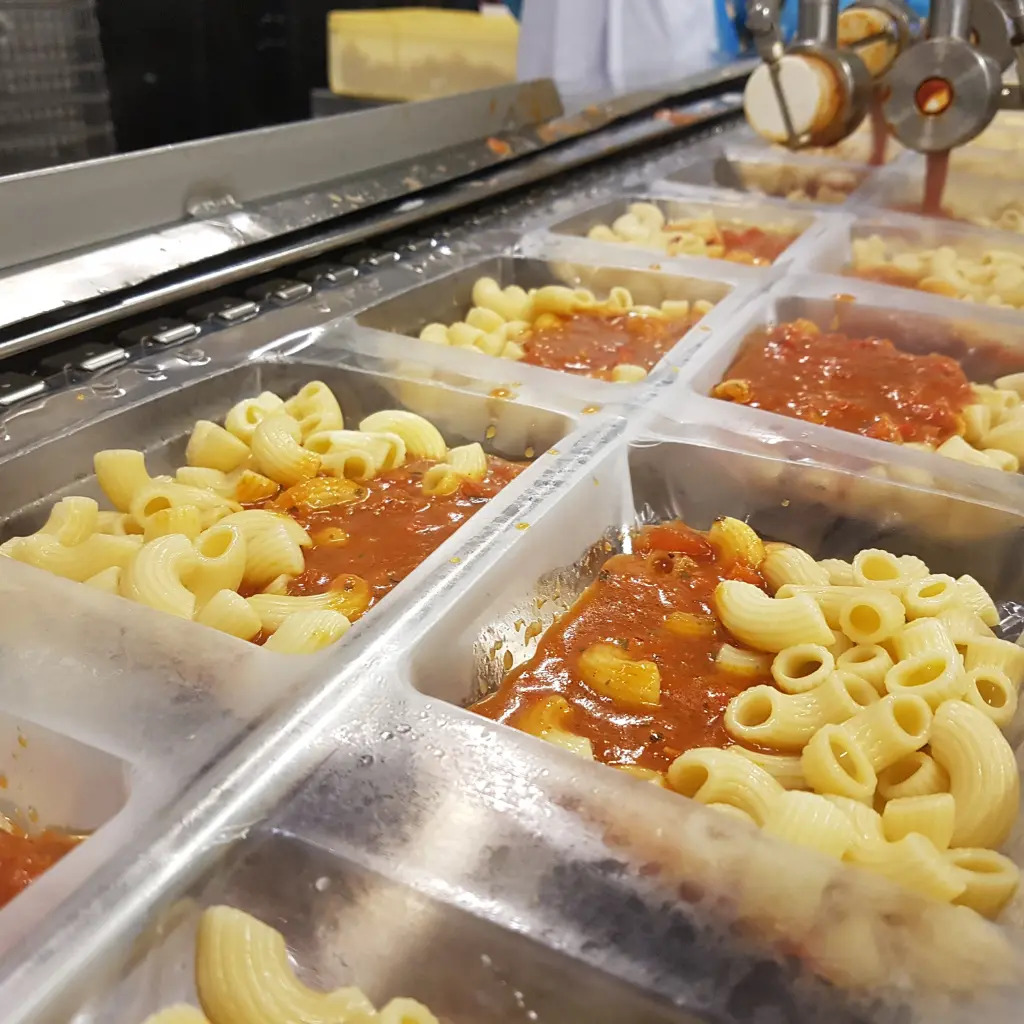
Savory Systems
AI in Food Manufacturing
Welcome to the captivating world of “Savory Systems: AI in Food Manufacturing.” In this culinary odyssey, we’ll explore how artificial intelligence, often synonymous with innovation, precision, and efficiency, reshapes the food industry.
From ensuring top-tier food quality to crafting optimal flavour combinations, from greening food operations to the gourmet experiences of the future, we’ll delve into the transformative role of AI at every step of the food production journey.
With the central keyword “AI in Food Manufacturing” as our guide, let’s embark on this delicious adventure into the future of food.
Table of Contents
Ensuring Top-Tier Food Quality
In the realm of AI in Food Manufacturing, precision is paramount. Artificial intelligence, equipped with its sharp vision, has revolutionized food quality control by enhancing efficiency. Through advanced image recognition, it swiftly identifies imperfections, ensuring each morsel meets the highest standards. Machine learning algorithms analyze vast datasets, fine-tuning the process and raising the bar for excellence.
But how does AI elevate quality control in food processing? Picture this: a conveyor belt whirring with fresh produce. AI-enabled cameras scan every inch, pinpointing irregularities and deviations from the norm. Whether it’s a bruise on an apple or a blemish on a carrot, nothing escapes its discerning gaze.
AI-powered food quality control detects visible defects and nuances in flavour and texture. It delves into the realm of machine learning in flavour profiles, discerning subtleties that escape the human palate. Imagine a symphony of taste and texture harmonized by algorithms that understand food at a molecular level.
As a result, the end product boasts unparalleled excellence, tantalizing taste buds and exceeding consumer expectations. How does AI not only refine quality but also optimize flavour profiles? This brings us to our next intriguing chapter: Creating optimal flavour combinations. How do machines master the art of taste? Let’s uncover the secrets.
Creating Optimal Flavor Combinations
Building on the foundations of AI in Food Manufacturing, where quality reigns supreme, we dive into the mesmerizing world of crafting impeccable taste experiences. How does AI orchestrate the perfect blend of flavours?
In this culinary symphony, machine learning in flavour profiles takes centre stage. AI algorithms, equipped with vast databases of ingredient properties, embark on a quest to discover flavour affinities. They analyze ingredients’ chemistry and sensory appeal in milliseconds, seeking the ideal partners for each dish.
Picture an AI-driven chef, a virtual maestro, leveraging data-driven insights to conjure delectable dishes. It’s not just about balance; it’s about pushing the boundaries of culinary artistry. Imagine a world where AI explores combinations beyond human intuition, creating taste sensations previously unimaginable.
But how do these flavour discoveries translate into gourmet experiences for us? The answer lies in AI-driven kitchens and menus, where every dish is a harmonious revelation. The future of food tantalizes our taste buds, but it doesn’t stop there. How does AI ensure these creations are not just exceptional but also efficient? The next chapter, Maintenance Efficiency in Food Processing, unveils the backstage magic that keeps the show running smoothly. What keeps these culinary wonders going?
Maintenance Efficiency in Food Processing
From the delightful world of flavours, we journey into the heart of food manufacturing, where precision meets productivity. But, in the realm of AI in Food Manufacturing, how do we ensure the seamless operation of the machines that craft culinary masterpieces?
Maintenance efficiency is the unsung hero, ensuring the kitchen never goes silent. AI brings predictive machinery maintenance to the forefront, embracing the AI-driven supply chain for perishables. Imagine a scenario where machines anticipate their own maintenance needs, scheduling repairs before breakdowns disrupt production.
These AI-driven systems are the guardians of efficiency, meticulously analyzing data to detect even the faintest signs of wear and tear. With predictive maintenance, costly downtimes become relics of the past. Machines operate at peak performance, and food production remains uninterrupted, ensuring freshness and quality.
But what happens beyond the kitchen walls? How does AI revolutionize the way fresh ingredients reach our tables? The next chapter, Fresh Supply Chains Powered by AI, unveils the journey of perishables, from farm to fork, optimized by artificial intelligence. How does AI ensure our food remains not only delectable but also sustainable? Let’s explore the trailblazing innovations.
Fresh Supply Chains Powered by AI
Continuing our culinary exploration, we delve into the critical domain of supply chains, where freshness is paramount. But how does AI in Food Manufacturing ensure that the journey from farm to table remains fresh and efficient?
Building on the efficiency we explored in maintenance, AI extends its prowess to optimize supply chains. In a world powered by an AI-driven supply chain for perishables, imagine a system that anticipates demand patterns, orchestrates logistics, and minimizes waste, all in real-time.
These AI systems are like conductors in a symphony, harmonizing the flow of goods. They analyze many factors, from weather forecasts affecting crop yields to consumer preferences influencing purchasing habits. The result? Reduced food spoilage, shorter delivery times, and an eco-friendly approach that aligns with sustainable practices in food processing.
But what happens when these fresh ingredients reach the manufacturing facility? The next chapter, Innovations in Food Packaging Automation, unravels the high-tech artistry that ensconces these treasures, safeguarding their quality and flavour. How does AI ensure that packaging aligns with the precision we’ve come to expect? Let’s peel back the layers of innovation.
Innovations in Food Packaging Automation
From the artistry of fresh supply chains, our journey now converges on the crucial domain of food packaging. As we’ve seen, AI in Food Manufacturing ensures that our ingredients remain pristine. But what about the final touch, the packaging that preserves quality and flavour?
This is where innovation takes centre stage, with robotics in food packaging leading the way. Picture a choreographed ballet of machines, each with a distinct role in the packaging process. These machines orchestrate the final act, from precision portioning to sealing with impeccable timing.
The magic lies in their ability to adapt. AI algorithms continuously learn and refine, ensuring that every package embodies perfection. They embrace sustainable materials, aligning with the principles of green operations in food processing while optimizing efficiency, reducing waste, and minimizing environmental impact.
But what lies beyond the package? How can AI not only preserve but also enhance our understanding of food? The next chapter, Using AI for Nutritional Insights, unveils the secrets held within every bite. How does AI uncover the hidden nutritional gems, shaping our choices in a healthier direction? Let’s dive into the science of sustenance.
Using AI for Nutritional Insights
Building on the fascinating innovations in food packaging, we now venture into the realm of understanding what we consume. How can AI in Food Manufacturing not only preserve the quality of our food but also provide us with vital nutritional insights?
Imagine your smartphone becoming your nutritionist. AI can decode the complex nutritional content of meals with its data analysis. It goes beyond what’s on the label, unveiling the hidden healthy treasures and potential allergens.
But it doesn’t stop there. AI can personalize recommendations based on individual health needs and dietary preferences, ushering in a new era of personalized nutrition. This opens doors to healthier eating habits, aligning with the concept of sustainable practices in food processing by reducing food waste and optimizing consumption.
Now, as we uncover the mysteries of our food, a vital question arises: How can AI also make understanding nutrition more eco-friendly? The next chapter, Green Operations in Food Processing, explores how technology can contribute to a greener, more sustainable food industry. How can AI continue to revolutionize our food journey while respecting the planet? Let’s embark on this innocent quest together.
Green Operations in Food Processing
As we journey through the world of food and technology, our exploration now focuses on the intersection of sustainability and food processing. We’ve seen how AI in Food Manufacturing enhances quality, flavour, and nutrition. But how can it also play a pivotal role in making these processes environmentally friendly?
Innovations in sustainable practices are at the forefront of modern food production. With its data-driven precision, AI is a critical player in reducing the carbon footprint. It optimizes energy consumption, minimizing waste, and maximizes resource efficiency, aligning seamlessly with the concept of sustainable practices in food processing.
Imagine a real-time food plant where AI algorithms monitor and adjust energy usage or reduce waste to near-zero levels through predictive analytics. Sustainability has become more than just a buzzword; it has become an integral part of production.
Now, envision a future where technology doesn’t just make food better but also kinder to our planet. But what about the workforce that will drive this greener food industry? The next chapter, Prepping the Next-Gen Food Industry Workforce, unravels how AI shapes the skills and knowledge required for a sustainable culinary future. How will technology empower the individuals who craft our food? Let’s explore the answers.
Prepping the Next-Gen Food Industry Workforce
Our exploration of the transformative power of AI in food processing brings us to a pivotal juncture: the people who will drive this culinary revolution. As we have seen the success of sustainable practices in food processing, the question arises: how can we equip the next generation of food industry professionals with the skills and knowledge needed to navigate this AI-powered landscape?
The food industry is evolving, and so too must its workforce. AI is not here to replace humans but to empower them. Training for AI in the food industry is crucial. Imagine a world where workers collaborate seamlessly with AI systems, enhancing efficiency, reducing errors, and elevating the culinary craft to new heights.
Institutions are adapting curricula to encompass AI-driven technologies in the educational sphere, preparing students to harness these tools effectively. These future professionals will play a pivotal role in shaping the food industry, ensuring sustainability, quality, and innovation remain at the forefront.
Now, as we ponder the potential of this next-gen workforce, we must ask: What stories will they write? The next chapter, AI-driven success stories in food, unveils the triumphs and innovations that arise when humans and AI work hand in hand. What remarkable feats lie on the horizon for the world of gastronomy and beyond? Let’s embark on this journey of discovery.
AI-Driven Success Stories in Food
As we navigate the culinary landscape enriched by AI, our journey brings us to the stories of triumph and innovation. Having explored how AI equips the next generation of food professionals, we now witness the real-world impact of AI in Food Manufacturing.
Imagine a small bakery that, with the aid of AI, optimizes ingredient sourcing, production schedules, and customer preferences. This newfound efficiency not only reduces waste but also enhances profitability. Such stories of transformation are becoming increasingly common.
In the realm of nutrition, AI is revolutionizing meal planning. Apps that use AI-driven nutritional insights create personalized meal recommendations, helping individuals achieve their health goals. These success stories involve not just taste but wellness.
Now, the question arises: How will AI continue to shape our culinary experiences in the future? The next chapter, Future Gourmet Experiences Shaped by AI, takes us on a tantalizing journey into the possibilities awaiting food lovers. What does the future hold for the fusion of technology and gastronomy? Let’s embark on this delicious adventure.
Future Gourmet Experiences Shaped by AI
As we relish the tales of AI’s triumphs in the food industry, we look to the horizon, where AI in Food Manufacturing promises to redefine the art of dining. Having witnessed AI-driven success stories, we envision a future where technology amplifies our culinary adventures.
Imagine stepping into a restaurant where an AI-powered sommelier selects the perfect wine to complement your meal, not just based on conventional pairings but also your personal preferences and health goals. This is the future of gourmet dining—personalized, precise, and delightful.
AI-driven chefs are poised to become our culinary companions, crafting dishes that push the boundaries of creativity. With access to a vast repository of recipes, ingredients, and flavour profiles, they’ll create gastronomic delights tailored to individual tastes and dietary needs, revolutionizing our dining experiences.
But what does this mean for sustainability and health? Can AI also steward ethical sourcing and nutrition in this gourmet future? As we wrap up our exploration of AI’s role in food manufacturing, we ask: How will these technological innovations shape how we eat, cook, and think about food? Let’s embark on this tantalizing journey into the future.
Conclusion
We’ve uncovered a symphony of innovation and transformation in AI in Food Manufacturing. From ensuring top-tier food quality to crafting optimal flavour combinations, AI’s role is pivotal.
AI-driven success stories illustrate how technology collaborates with culinary professionals, making our meals more efficient, healthier, and eco-friendly. It’s a journey where AI enhances what’s on our plates and empowers the workforce, shaping our food industry.
As we peer into the future, we envision gourmet experiences shaped by AI, where personalized dining and culinary creativity reach unprecedented heights. Picture AI-powered sommeliers and chefs offering tailored experiences while upholding sustainability and health.
But what’s next? How will these technological marvels evolve? The future of food production with AI is poised to embrace more sustainability, reducing waste and environmental impact. It will continue empowering the next generation of food professionals, ensuring they can navigate this culinary revolution.
AI’s presence in food manufacturing isn’t just about innovation; it’s a gastronomic evolution. It’s about precision, sustainability, and the fusion of tradition with technology. So, as we savour the delicious possibilities on the horizon, let’s keep asking: What’s next in the ever-exciting world of AI and food?
Related Articles
- AI in Paper Manufacturing: Pulp and Processors
- AI in Agri-Equipment Manufacturing: Fields and Functions
- AI in Footwear Manufacturing: Steps Ahead
- AI in Jewellery Manufacturing: Gems and Generative Models
- AI in Glass Manufacturing: Crystal Clear Computing
- AI in Construction Material Manufacturing: Bricks and Bytes
- AI in Chemical Manufacturing: Molecular Models
- AI’s Role in Electronic Manufacturing: Circuitry and Systems
- AI’s Revolution in Polymer Production: Reshaping Plastics
- AI in Furniture Manufacturing: Crafted by Code
- AI in Ceramic Production: Fired by Future
- AI in Metal Fabrication: Moulded by Machines
- AI in Aerospace Manufacturing: Beyond the Atmosphere
- AI’s Integration in Pharmaceutical Manufacturing: Pills and Processes
- AI in the Automotive Industry: Driving Production
- Weaving AI into Textile Manufacturing: Threads and Tech
- IPA in Manufacturing Sector: How AI Tools Revolutionize Efficiency, Productivity, and Quality

Arindam Roy
An Automation Consultant with 25+ years of IT Experience
Forbes Articles related to AI usage in the Manufacturing Sector:


